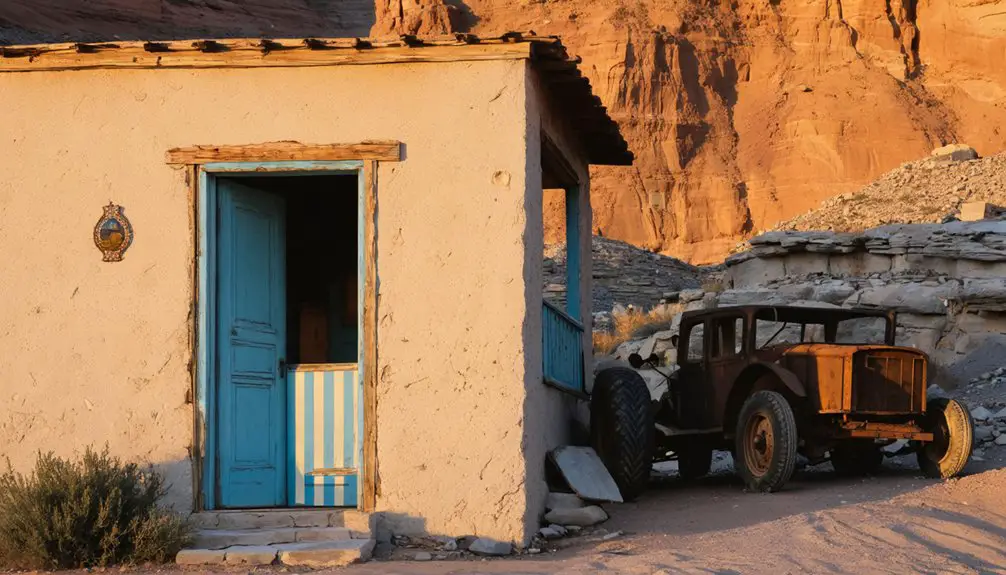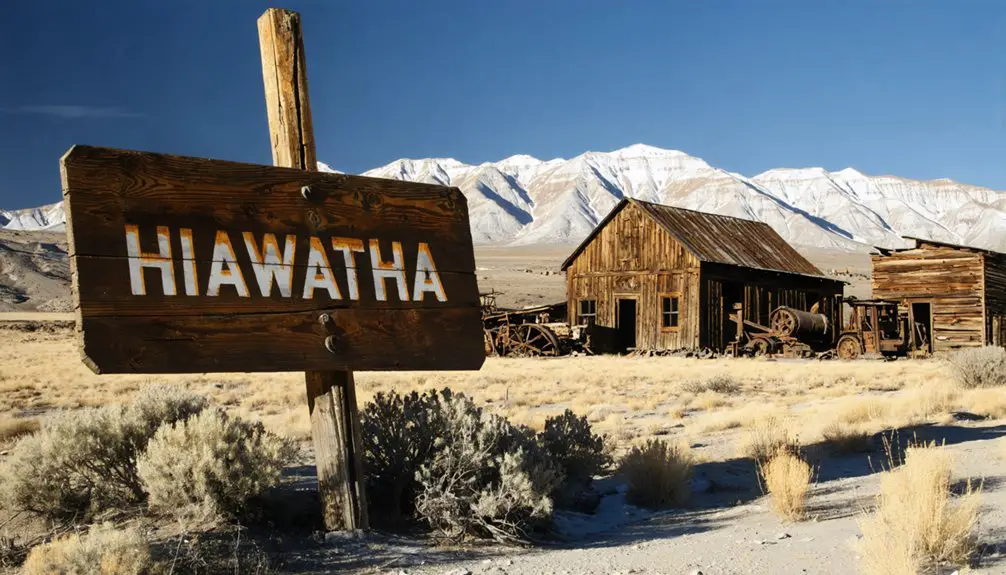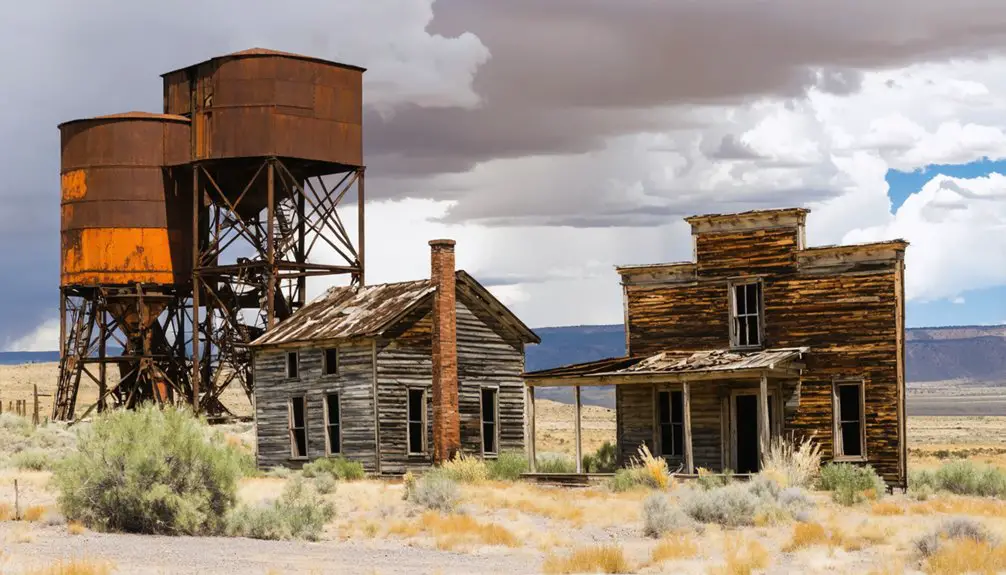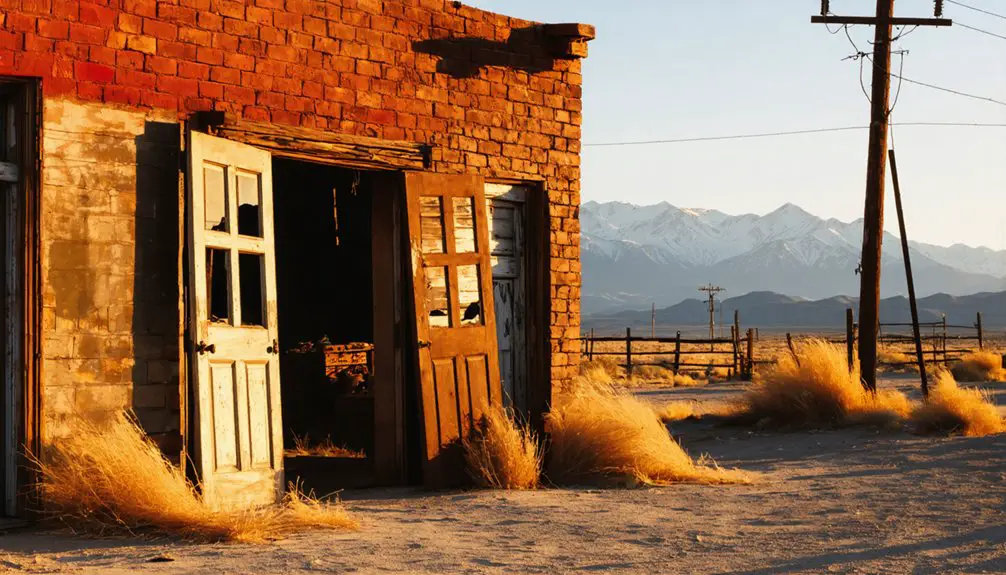You’ll find Hiawatha nestled at the base of Utah’s Gentry Mountains, where it emerged as a bustling coal mining town in 1907. At its peak in the 1940s-50s, this company town housed 1,500 residents, including a thriving Greek immigrant community. The United States Fuel Company controlled daily life, from housing to the company store. Today, spanning 55 acres, Hiawatha’s weathered buildings and mining relics tell a deeper story of Utah’s coal mining heritage.
Key Takeaways
- Hiawatha was established in 1907 as a coal mining town in Carbon County, Utah, reaching its peak population of 1,500 residents.
- The town thrived on coal mining operations run by United States Fuel Company, with residents living in company-owned housing.
- Greek immigrants formed a significant part of the community, establishing cultural institutions and businesses throughout the town.
- The population declined dramatically in the 1960s, dropping from 1,500 to just 200 residents by the 1980s.
- Today, Hiawatha exists as a 55-acre ghost town featuring weathered buildings and mining relics from its coal-mining heyday.
The Birth of a Mining Town
While coal deposits had long been known in Carbon County, Utah, the establishment of Hiawatha didn’t begin until 1907 when the first mine opened at the base of the Gentry Mountains.
The town’s origins trace back to Pennsylvania, as it was named after a prominent coal mine there, with “Hiawatha” referencing the legendary Mohawk chief from Longfellow’s famous poem. The community grew rapidly after 1908, eventually reaching nearly 1500 residents at its peak.
A significant number of early miners came from Crete, Greece, establishing a strong Greek presence in the developing mining community.
Railroad’s Arrival and Economic Growth
The rapid growth of Hiawatha’s coal operations in the early 1900s demanded more efficient transportation than the existing inadequate rail lines could provide. The railroad significance became clear when Utah Coal Railway incorporated in 1912, ushering in an era of economic transformation that would reshape the region’s future. The Southern Utah Railroad Company had established a 3.5 mile track that served as an important link from Castle Junction to Hiawatha.
By 1913, there was a severe backlog with 1,400 unfilled orders for coal cars due to transportation limitations.
- You’d have witnessed the construction of a superior standard gauge railroad, carefully engineered with manageable 1-2% grades.
- Your coal could now reach broader markets through connections to national rail networks.
- You’d see the town’s only formal depot at Kingmine, marking Hiawatha’s importance.
- Your mining operations could expand dramatically with reliable rail infrastructure.
- You’d benefit from the railway’s strategic advantage over competitors, using better routes and equipment.
The railroad’s arrival revolutionized Hiawatha’s potential, connecting your coal to America’s growing energy needs.
Peak Years and Population Boom
The post-World War II demand for coal transformed Hiawatha into a bustling community of 1,500 residents, nearly tripling its earlier population.
You’d find U.S. government housing projects sprouting up to accommodate returning veterans, while the U.S. Fuel Company operations drew workers from diverse backgrounds to the mines.
The town’s rapid expansion brought essential amenities including a doctor’s office, school, church, and social halls – creating a vibrant community life that defined Hiawatha’s peak years in the 1940s and 1950s.
Post-War Growth Surges
Following World War II, Hiawatha experienced unprecedented growth as its population tripled from 500 to approximately 1,500 residents during the 1940s and 1950s.
The post war economy thrived on increased coal demand, transforming this small mining town into a bustling community. You’d have witnessed the coal industry’s remarkable expansion as the United States Fuel Company ramped up operations to meet national energy needs.
- Government housing projects welcomed returning veterans and their families
- New infrastructure included expanded stores and community buildings
- Greek immigrants, especially from Crete, formed a significant part of the workforce
- Ethnic neighborhoods developed, creating distinct cultural enclaves
- Supporting amenities grew to include a post office, school, church, and entertainment venues
Mining Jobs Draw Workers
Mining operations in Hiawatha sparked a dramatic workforce expansion starting in 1907, when the first coal mine opened under United States Fuel Company management.
You’d find diverse job opportunities throughout the peak years, as Greek immigrants from Crete joined experienced miners from other nations, creating a vibrant multicultural workforce that reached 1,500 residents by the 1940s.
The company town offered essential amenities to support workers facing daily workforce challenges underground. You could access company housing, medical facilities, and education through eighth grade for your children.
The completion of the railroad in 1914 connected Hiawatha to broader markets, while nearby mines like Castle Valley Coal at Mohrland created additional employment options.
During World War II, returning veterans found steady work as government housing projects expanded to meet growing demand.
Housing Demands Expand
During the post-World War II years, Hiawatha’s housing landscape transformed dramatically as its population swelled from 500 to 1,500 residents.
Housing policies adapted quickly to accommodate returning veterans through government projects, while the U.S. Fuel Company’s consolidation of mines drove centralized development.
You’ll find Hiawatha’s community layout reflected both practicality and the era’s social dynamics:
- Modest frame houses arranged in neat rows across 55 acres
- Segregated ethnic enclaves, particularly for Greek immigrants from Crete
- Federal housing projects specifically designed for WWII veterans
- Communal facilities including stores, churches, and an 8th-grade school
- Boarding houses built for single miners
This well-planned expansion supported the town’s peak mining years, with infrastructure like railways, medical offices, and entertainment halls creating a self-sustaining community where families could thrive.
Greek Heritage and Immigrant Life

As you explore Hiawatha’s peak mining years, you’ll discover a vibrant Greek community that emerged by 1905, primarily consisting of immigrants from Crete who came seeking coal mining opportunities.
These Greek miners established tight-knit ethnic enclaves, sharing living quarters with fellow countrymen and maintaining their cultural traditions through community gatherings and religious observances. World War I brought increased hostility toward Mediterranean immigrants in the mining towns.
The immigrants’ influence extended beyond the mines as many Greeks shifted into successful business owners, operating coffeehouses, restaurants, and grocery stores that served both their ethnic community and the broader population with imported Mediterranean goods. Following the example of pioneers like John G. Diamanti, these early Greek settlers laid the foundation for a lasting cultural legacy in Utah’s mining communities.
Greek Mining Community Life
Greek immigrants, primarily from Crete, transformed Hiawatha’s workforce and cultural landscape in the early 1900s, establishing a vibrant ethnic community within the coal mining town. The town’s Carbon Coal and Coke Company employed most of the Greek workers, providing steady jobs for decades.
You’ll find their settlement patterns centered around tight-knit neighborhoods, where social networks flourished despite initial immigrant challenges. Coming from regions under Ottoman control, many settlers sought economic opportunities and escape from military conscription.
- Greek laborers advanced from miners to mechanical and supervisory roles
- Coffeehouses served as cultural hubs and informal employment networks
- Religious observances in makeshift spaces united the scattered community
- Limited presence of Greek women shaped early family dynamics
- Community leaders negotiated for infrastructure and cultural preservation
The Greek community’s resilience showed through their socioeconomic mobility, with many rising from laborers to business owners.
Their cultural identity remained strong through religious gatherings, while labor roles evolved from basic mining work to skilled positions, demonstrating their growing influence in Hiawatha’s development.
Cultural Traditions and Bonds
While establishing their cultural foothold in Hiawatha’s mining community, immigrant families from Crete and mainland Greece wove a rich tapestry of traditions that you’d find expressed through their Orthodox faith, ethnic newspapers, and vibrant social institutions.
You’d discover Greek coffeehouses serving as essential social hubs where cultural preservation thrived, though labor agents sometimes exploited these gathering spots. The mining companies relied on labor agents to recruit workers, similar to how E.D. Hashimoto’s agency brought Japanese laborers to Utah mines.
The community’s ethnic identity remained strong through their Greek-language newspapers, which kept you informed about church events, weddings, and social life. Beginning in post-World War II, the Greek population expanded significantly as mining operations grew to meet increased coal demand.
Local Greek stores stocked imported delicacies like olive oil, octopus, and Turkish tobacco, while the Orthodox Church served as the cornerstone of spiritual and cultural life.
Despite living in segregated sections, you’d notice how shared mining experiences created lasting bonds between Greeks and other immigrant groups, including Italians and Japanese.
Mining Operations and Infrastructure
When the United States Fuel Company opened its first coal mine near Hiawatha in 1907, they established what would become one of Utah’s significant mining operations.
The company consolidated with Castle Valley Coal in 1912, expanding their reach and implementing advanced mining technology and coal preparation facilities.
You’ll find these key operational components that made Hiawatha thrive:
- A strategic railroad extension built in 1914 connecting to Helper
- A large rail yard and coal loadout facility east of town
- Underground mining systems using period-specific extraction methods
- Specialized coal preparation plants for processing
- Multiple tram wheel houses and conveyor systems
The Story Behind the Name

The distinctive name “Hiawatha” emerged from multiple cultural influences that shaped this Utah mining town’s identity.
You’ll find Hiawatha‘s origin traced to a prominent Pennsylvania coal mine, but its deeper roots connect to Native American heritage through the legendary Mohawk chief Hiawatha of the Iroquois League.
The literary influence of Henry Wadsworth Longfellow‘s famous poem “The Song of Hiawatha” likely inspired the mine’s discoverer around 1909, reflecting the era’s romanticized view of American Indian culture.
The name’s cultural significance extended beyond mere identification – it represented a departure from typical geographic or industrial naming conventions of mining towns.
When the community consolidated its post office and government from Black Hawk around 1915, Hiawatha became the unified identity that would persist until its disincorporation in 1992.
Daily Life in a Company Town
Life in Hiawatha revolved entirely around the United States Fuel Company‘s coal operations, which controlled every aspect of residents’ daily existence.
Every facet of daily life in Hiawatha fell under the United States Fuel Company’s control, with coal mining dominating the community.
You’d find yourself living in company-owned housing, shopping at the company store, and working under strict company control in the mines. Labor conditions were demanding, though they improved after 1933 with union recognition.
Your daily routine might’ve included:
- Walking to work past rows of identical frame houses, segregated by ethnic background
- Sending your children to the local eighth-grade school
- Purchasing necessities at the company store
- Seeking medical care from the town’s designated doctor
- Spending evenings at the amusement hall or church for entertainment
The company’s influence extended beyond work hours, shaping everything from housing assignments to social interactions in this tightly controlled community.
Decline and Abandonment

Hiawatha’s bustling company town atmosphere began to unravel during the 1960s, marking a stark shift from its tightly controlled community life.
You’d have witnessed the town’s decline as economic factors hit hard – coal veins diminished, and nationwide demand dropped, causing U.S. Fuel Company to downsize operations dramatically.
Despite the community’s resilience, you couldn’t ignore the exodus that followed. The population plummeted from 1,500 in the 1950s to merely 200 by the 1980s.
One by one, you’d have seen familiar landmarks disappear – the company store, church, and amusement hall fell silent.
Modern Day Ghost Town Legacy
Standing as a symbol of Utah’s mining heritage, today’s Hiawatha spans roughly 55 acres of weathered buildings and mining relics that draw curious visitors throughout the year.
Since its disincorporation in 1992, ghost town preservation efforts have focused on maintaining the site’s cultural heritage while allowing natural weathering to tell the story of this once-thriving mining community.
Time and elements slowly reshape Hiawatha’s remnants, preserving both its physical structures and the stories they silently tell.
- Original company store and school buildings remain as representations of community life
- Former residential structures showcase distinct ethnic neighborhoods
- Mining infrastructure remnants illustrate industrial operations
- Manti-La Sal National Forest surrounds the townsite, limiting development
- Former residents and descendants visit to maintain family connections
You’ll find no permanent residents here, but the site continues to attract historians, tourists, and those seeking to explore Utah’s rich mining past.
Frequently Asked Questions
Are There Any Paranormal or Supernatural Reports From the Abandoned Town?
You’ll find frequent ghost sightings around the mines, including the famous White Lady spirit. Local legends tell of unexplained voices, shadow figures, and paranormal activity in the museum and drying room.
What Happened to the Original Mining Equipment and Machinery?
Like ghosts of industry past, you’ll find the mining technology left to rust – some equipment was sold off, while other machinery remains abandoned onsite, with minimal preservation efforts due to private ownership restrictions.
Can Visitors Take Artifacts or Souvenirs From the Site?
No, you can’t legally or ethically remove artifacts from this private property. Souvenir ethics and artifact preservation laws strictly prohibit taking anything – it’s trespassing and undermines historical research value.
Which Original Buildings From the Mining Era Still Remain Standing?
Like weathered sentinels of time, you’ll find miners’ houses along the railroad tracks, the company store ruins, former post office, mine portal buildings, and headquarters building – all standing evidence to historic preservation’s architectural significance.
You’ll find few firsthand oral histories from original residents today, though descendants occasionally share personal anecdotes through genealogy forums and local history groups, keeping memories alive despite the town’s 1992 disincorporation.
References
- https://utahrails.net/utahcoal/hiawatha-town.php
- https://onlineutah.us/hiawathahistory.shtml
- https://www.familysearch.org/en/wiki/Hiawatha
- http://www.expeditionutah.com/forum/index.php?threads/ghost-town-hiawatha-black-hawk.5694/
- https://en.wikipedia.org/wiki/Hiawatha
- https://utahrails.net/utah-ry/utah-ry-history.php
- https://utahrails.net/johnson/johnson-chap4.php
- https://www.american-rails.com/utah.html
- https://historytogo.utah.gov/railroads-utah/
- https://kids.kiddle.co/Hiawatha



